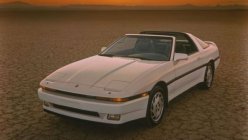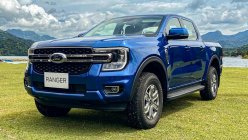The current Ford Ranger marks a decade of existence this year, having been introduced in October of 2010. Although the name was originally used on three separate Ford model lines, the Ranger as we know it in our market started out as a Japanese make in 1998.
The New Ford Ranger | Ford Philippines
If you think it’s a bit confusing, we’ll lay down a timeline to track how much the Ranger has changed.
First Generation Ranger
In 1972, Ford sold its Courier line of compact pickups as a rebadged Mazda B-Series, wanting to cash in on the popularity of similar offerings from Toyota and Nissan/Datsun.
This continued until the second generation in 1983 when the Courier was replaced by the Ford Ranger in North America yet would live on in international markets for another 15 years.

First-generation Rangers were built on the Mazda B-Series platform
In 1998, the fifth-generation Mazda B-Series began to be sold as the first-generation Ford Ranger for customers in Europe and Asia, with the Philippines even commencing local production.
As a rebadged model, it shared the rounded edges of its B2500 donor, as well as a 2.5L inline-four diesel engine or its turbocharged equivalent, with a 4x2 or 4x4 drivetrain.
Sporting a four-door double cab body, the B-Series-based Ranger found favor with customers looking for Japanese reliability with the prestige of an American nameplate, and was sold for eight years. A mid-cycle refresh in 2004 gave the Ranger a revised grille and larger headlamps
>>> Related: Which 2020 Ford Ranger should you buy? [Philkotse Guide]
Second Generation Ranger
In 2006, Mazda retired the B-Series in favor of the BT-50, which served as the platform for the second-generation Ranger. Again, both the Ranger and BT-50 shared the same body and 2.5L Duratorq/3.0L diesel inline-4 engines, with common rail direct injection technology. The grille was replaced with bigger slats bookended by larger headlamps.
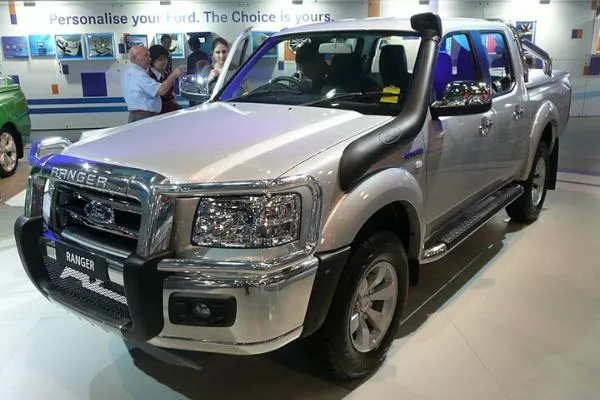
The Mazda BT-50 platform gave the second-generation Ranger more muscle
The new platform also raised the Ranger’s ride height, apart from giving it a more muscular stance with wider fenders. Cargo bed capacity was also increased, improving the Ranger’s cargo capability. A 2009 facelift gave the Ranger an even wider grille with swept-back headlamps.
Third Generation Ranger
The third-generation Ranger was unveiled in 2011, now designed and engineered by Ford in Australia, sporting its own T6 platform for the first time.
The dimensions were increased even further, placing the Ranger into the midsize pickup category. A slimmer three-bar grille sits on the fascia, placed between wraparound headlamps.
>>> Related:
- 2020 Ford Ranger vs Toyota Hilux Comparison: Spec Sheet Battle
- 2020 Mitsubishi Strada Athlete vs Ford Ranger Raptor Comparison: Spec Sheet Battle

Improved aerodynamics and increased wading capability marked the third generation
The new Ranger’s sleeker and more dynamic look, punctuated by large yet subtle fenders, was an engineering feat that improved aerodynamics, with a drag coefficient of .399 Cd, impressive for its class.
A double-cab body was still the default, coming in a choice of three variants (XL, XLT, Wildtrak) and two engines (2.2L and 3.2L Duratorq turbodiesels), mated to either a six-speed manual or six-speed automatic, with 4x2 and 4x4 drivetrains.
Bigger measurements meant best-in-class interiors for this generation, while a higher ground clearance and raised air intake contributed to the class-leading wading depth of 800mm.
Current Generation Ranger
The present Ranger is a 2015 refresh still riding on the T6 platform which, in an interesting twist, is now adopted by the current Mazda BT-50. Elements of Ford’s Kinetic Design language can be seen on the fascia, which features a revised trapezoidal grille, redesigned hood, and slimmer headlamps.
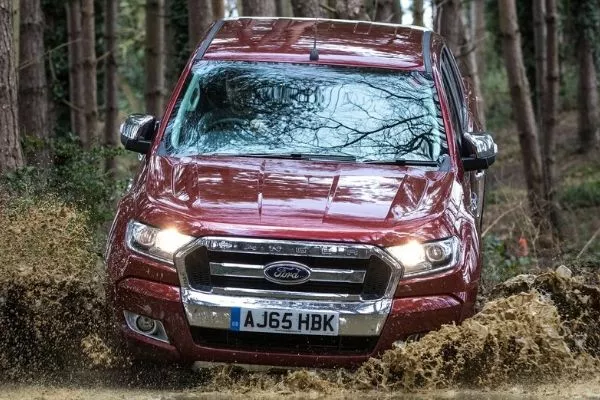
The current Ranger boasts more power than before
>>> Related: Ford Ranger car price in the Philippines
Retuned springs and dampers improve handling and cargo payload, while the hydraulic steering has been upgraded to a new electric power assist (EPAS) system for agility and fuel economy.
Transmission choices and drivetrain options remain the same, with engine output receiving a power boost for the 2.2L engine (158 hp and 385 Nm of torque). Meanwhile, the 3.2L power plant still makes 197 hp and 470 Nm, but with peak torque coming later in the powerband (2,000 rpm from 1,750).

The Ranger started out on a Japanese chassis
It even serves as the platform for the more lifestyle-oriented Ranger Raptor, which somewhat compromises on payload capacity in exchange for a FOX sport suspension setup, underbody bash plates, and a more powerful 2.0L bi-turbo diesel generating 210 hp and 500 Nm of twist.
The Ranger has indeed come quite a long way from its Japanese roots. Judging by the public’s continued patronage of the nameplate, we can expect further iterations of the Ranger to take our breath away.
Relive the history of your favorite rides with Philkotse.com.
Know more about Ford Ranger 2026

The 2025 Ford Ranger is a 4x4 or 4x2 pickup truck. It is the latest version of the said model, and as of its launch in the Philippine market, it has a total of six different variants.
These are the top-spec Wildtrak 4x4, Wildtrak 4x2, Sport 4x4, Sport 4x2, XLT 4x2, XLS 4x2 AT, XLS 4x2 MT, and the entry-level XL 4x4. As of 2025, prices for these trims range from Php 1,269,000 to Php 1,965,000.
Under the hood of the new Ranger are two different diesel mills. For the Wildtrak 4x4, it uses a 2.0-liter biturbo that can churn out 210 horsepower and 500 Nm of torque. It is also the sole trim that uses a 10-speed automatic tranny.
The rest of the all-new Ranger then gets a 2.0-liter turbodiesel that can produce up to 170 horsepower and 405 Nm of torque. Only the XLS 4x2 and the XL 4x4 may come with a six-speed manual. The other non-biturbo trims then use a six-speed automatic.
Size-wise, the all-new Ranger is 5,370mm long, 1,918mm wide, and 1,884mm in height. They also offer a wheelbase length of 3,270mm and a ground clearance of 235mm.
Locally, the Ford Ranger faces the Toyota Hilux, Nissan Navara, Mitsubishi Strada, Isuzu D-Max, Mazda BT-50, etc.
The Ford Ranger Wildtrak 4x4 | Philkotse Features
>>> New and used Ford Ranger 2025 for sale in the Philippines
Ford Ranger Exterior
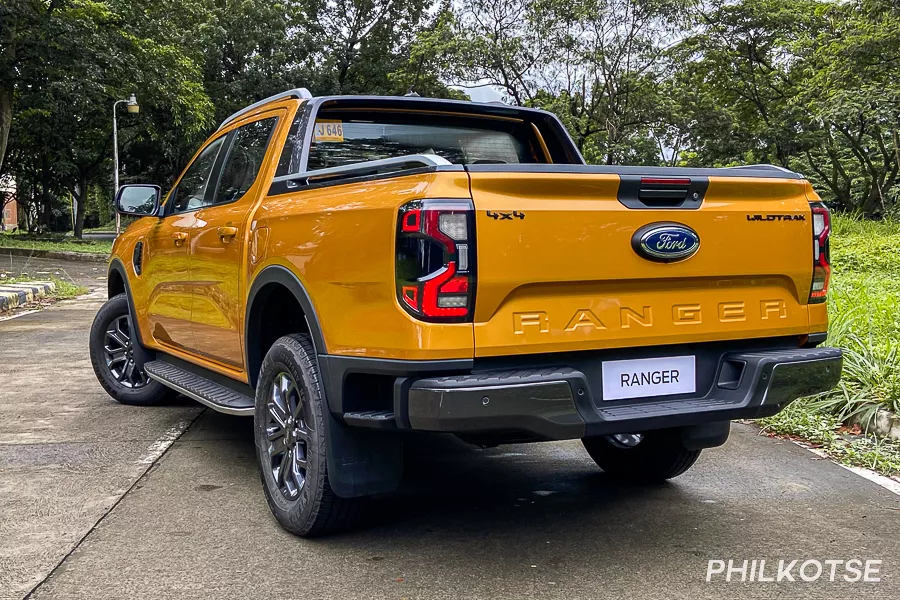
Depending on the variant, the all-new Ranger is equipped with LED headlamps and LED taillights. It also gets LED front fog lamps, as well as LED daytime running lamps. On the top-spec Wildtrak 4x4, its headlamps are adaptive Matrix LED headlamps.
Most trims except the XLS 4x2 and XL 4x4 also come with power-folding and power-adjustable side mirrors, a bedliner, roof rails, rain-sensing wipers, and an easy-lift tailgate. All do come with front and rear mud flaps.
>>> Read more information about the Ford Ranger:
- Next-gen Ford Ranger among 2023 Women’s World Car of the Year finalists
- Next-gen 2023 Ford Ranger is truck made for work and play, owners say
Ford Ranger Launch
The all-new 2025 Ford Ranger is the fourth-generation version. It was developed by Ford Australia, and the production for the said model started in Thailand in 2022.
Locally, the all-new Ranger will debut locally in July 2022. As of its launch, it has a total of seven different trims.
Ford Ranger Interior
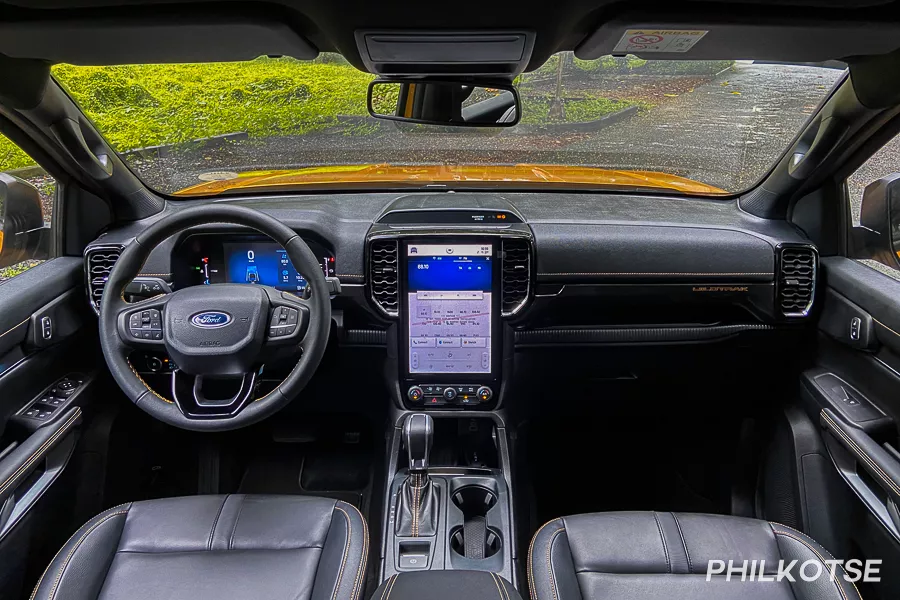
At the most, the new Ranger can seat up to five occupants. The higher-spec trims of this model also get a dual-zone automatic climate control system, smart entry, a push-to-start button, and an auto-dimming rearview mirror, among others.
Only the Wildtrak variants get the Wildtrak-style decorations for their leather and synthetic leather seats. The mid-spec Sport seats are wrapped with the same material, though the entry-level XLT, XLS, and XL get fabric seats.
The front seats for the Wildtrak are also power-adjustable. Most variants except the XLS and XL then come with a center folding armrest for their rear bench seats.
Technology & Safety Features
For entertainment, the Wildtrak trims come with a 12-inch touchscreen, while the rest get a smaller 10-inch headunit. All do come with Sync 4 software, as well as wireless Apple CarPlay and Android Auto connectivity. The Ranger then gets a total of six speakers, except for the XL trim which comes with four.
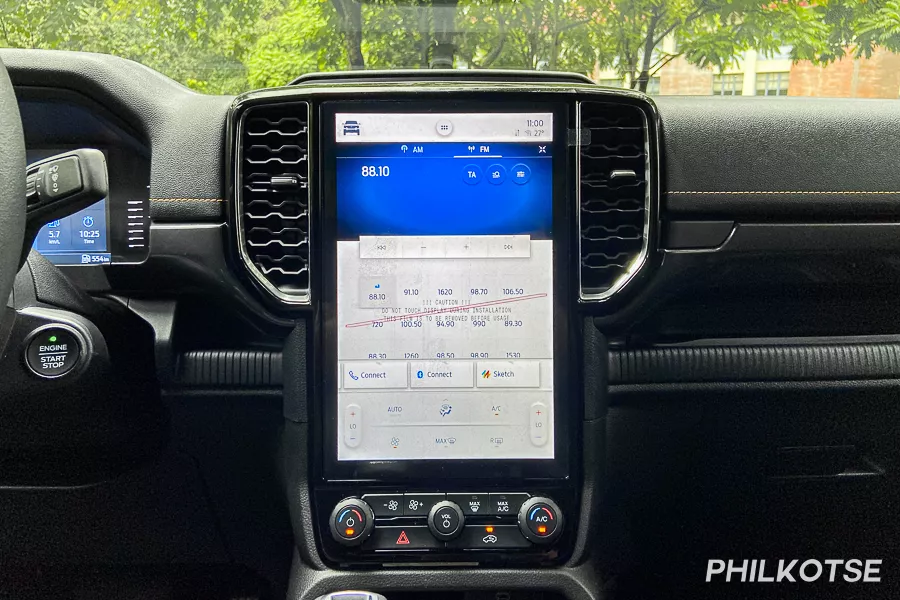
For safety, all trims get anti-lock braking and ISOFIX child seat anchors. Only the 4x4 trims, however, get hill-descent control. All variants except the XL also come with hill launch assist and rollover mitigation.
The Wildtrak variants then come with seven airbags, whereas the rest get six airbags. The only trim that doesn't have electronic stability is the XL.
Regarding driver assist features, only the top-spec Wildtrak 4x4 gets an automatic emergency braking system, adaptive cruise control, lane departure warning, lane keep assist, blind-spot monitoring, rear-cross traffic alert, a 360-degree camera, evasive steering, etc.
The mid-spec models like the Sport and Wildtrak 4x2 do come with cruise control.
Platform & Chassis

The latest version of the Ranger uses the ladder-frame T6 platform. Currently, it shares this with the Ford Bronco, Ford Everest, and the Volkswagen Amarok.
For the front, this pickup truck uses a double-wishbone-type suspension. It then gets leaf springs for the rear. Only the Wildtrak models come with disc brakes all around. The rest then come with a front disc brake and a rear drum brake.
Only the 4x4 trims come with an electronic locking rear differential. These are the Wildtrak 4x4, Sport 4x4, and the XL 4x4.
For wheels, the XLT uses a 17-inch alloy set, while the XLS gets a 16-inch alloy set. Only the entry-level XL gets a 16-inch steel set. In turn, the Wildtrak and Sport trims ride on an 18-inch alloy set.
Ford Ranger Engine & Drivetrain
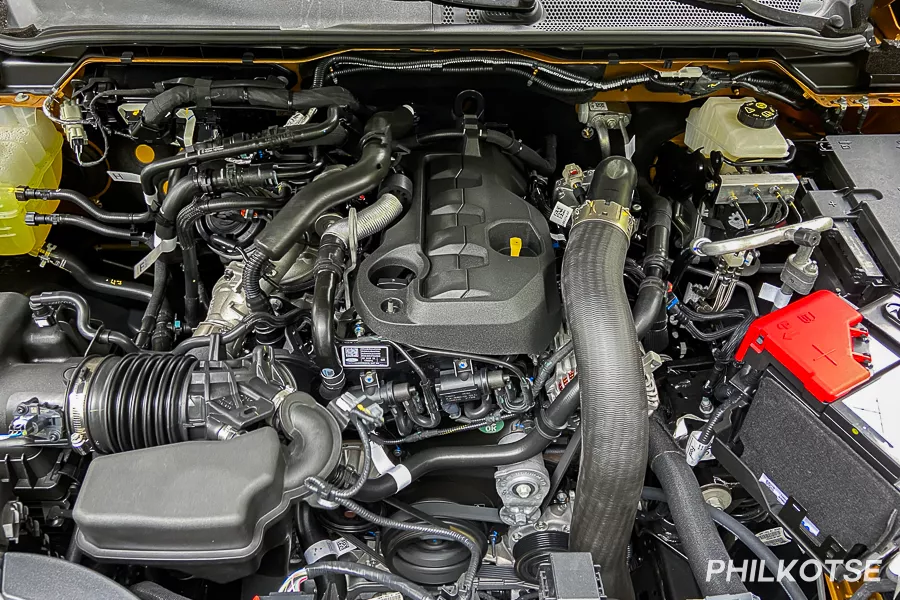
The 2025 Ford Ranger has two different engine options. For the Wildtrak 4x4, it utilizes a 2.0-liter biturbo diesel that can produce up to 210 horsepower and 500 Nm of torque. It is also the only variant that gets a 10-speed automatic.
The rest meanwhile, uses a 2.0-liter single turbo diesel mill. At maximum, this four-banger is good for 170 horsepower and 405 Nm of torque. This engine is then paired with a six-speed automatic tranny, or a six-speed manual gearbox.
Ford Ranger 2025 Price List
Let's check out the Ford Ranger 2025 price in the Philippines.
| Variants | Price |
|---|---|
| Ford Ranger 2.0 Turbo XL 4x4 MT | ₱1,523,000 |
| Ford Ranger 2.0 Turbo XLT 4x2 AT | ₱1,679,000 |
| Ford Ranger 2.0 Turbo Sport 4x2 AT | ₱1,805,000 |
| Ford Ranger 2.0 Turbo Wildtrak 4x2 AT | ₱1,949,000 |
| Ford Ranger 2.0 Turbo Sport 4x4 AT | ₱1,949,000 |
| Ford Ranger 2.0 Turbo Wildtrak 4x2 AT (Snowflake White Pearl) | ₱1,964,000 |
| Ford Ranger 2.0 Bi-Turbo Wildtrak 4x4 AT | ₱2,340,000 |
| Ford Ranger 2.0 Bi-Turbo Wildtrak 4x4 AT (Snowflake White Pearl) | ₱2,355,000 |
Ford Ranger 2025 FAQs
1. In terms of size does the 2025 Ford Ranger change?
The 2025 Ford Ranger is two inches bigger and two inches longer than it was before in terms of size.
2. Which engine will power the Ford Ranger in 2025?
The 2.3-liter turbo-four in the Ford Ranger produces 270 horsepower and 310 pound-feet of torque.
3. How much will the Ford Ranger 2025 cost?
The price of the Ford Ranger ranges from P1,259,000 to P1,955,000, depending on the variants.
4. How many colors will the Ford Ranger 2025 be available?
The Ford Ranger 2025 will be available in 4 colors: Absolute Black, Arctic White, Code Orange, and Conquer Gray.
₱ 1,213,000 - ₱ 1,910,000
ExploreRecent posts
- Ford Ranger Thunder is the limited, sinister-looking truck we want Apr 12, 2021
- Modified Ford Ranger Raptor: Tips & tricks to upgrade your sports truck Aug 18, 2023
- This Ford Ranger Raptor mod brings Pimp My Ride back to life Mar 18, 2021
- Ford Ranger Raptor not enough? Here’s a 360-hp Ranger VelociRaptor Apr 08, 2021
- Ford Australia might give the Ranger Raptor a V8 Apr 13, 2021


